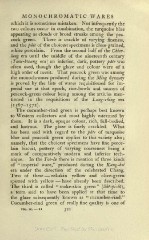Page 395 - Oriental Series Japan and China, Brinkly
P. 395
MONOCHROMATIC WARES
which it is sometimes mistaken. Not infrequently the
two colours occur in combination, the turquoise blue
appearing as clouds or broad streaks among the pea-
cock green. There is crackle of varying fineness,
and the pate of the choicest specimens is close-grained,
white porcelain. From the second half of the Chien-
lung era until the middle of the nineteenth century
( Taou-kwang era) an inferior, dark, pottery pate was
often used, though the glaze and colour were of a
high order of merit. That peacock green was among
the monochromes produced during the Ming dynasty
is proved by the lists of wares requisitioned for im-
perial use at that epoch, rice-bowls and saucers of
peacock-green colour being among the articles men-
tioned in the requisitions of the Lang-eking era
(1567-1572).
The cucumber-rind green is perhaps best known
to Western collectors and most highly esteemed by
them. It is a dark, opaque colour, rich, full-bodied,
and lustrous. The glaze is finely crackled. What
has been said with regard to the pate of turquoise
blue and peacock green applies to this variety also
;
namely, that the choicest specimens have fine porce-
lain biscuit, pottery of varying coarseness being a
mark of comparatively modern and inferior tech-
nique. In the Tao-lu there is mention of three kinds
of " imperial ware," produced during the Kang-hsi
era under the direction of the celebrated Chang.
Two of these eel-skin yellow and olive-green
spotted with yellow have already been described.
The third is called "snake-skin green" (She-pi-lu},
a term said to have been applied at that time to
the glaze subsequently known as " cucumber-rind."
Cucumber-rind green of really fine quality is one of
VOL. IX. 21 321

